The 1898 Exhibition marks an important and decisive turning-point in Shroud history and in the knowledge of the Shroud itself. Until then, the Shroud had been considered only on a devotional plane. After the first photograph taken of the cloth led to the discovery of the image's negative properties, it became an object of examination on a scientific plane as well.
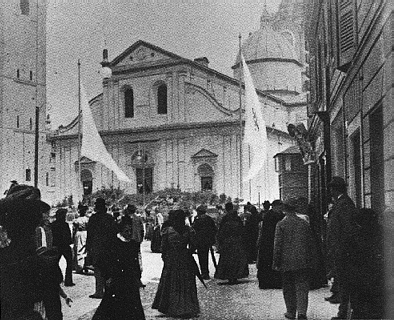 |
The square of the Cathedral during the 1898 Exhibition
Historians, archaeologists, exegetes, art critics, physicians and biologists began to study it from a totally different point of view. The Exhibition was allowed by the House of Savoy to solemnize the wedding between Crown Prince Vittorio Emanuele (III) and Montenegrin Princess Elena Petrovich-Niegos and it was inserted in ampler civic and religious manifestations celebrated in Italy and in Turin. The idea to celebrate the Albertino Statute's 50th anniversary with a solemn manifestation rose during autumn 1893 inside the society "La Libertà", one of the most meritorious, provident and hard working associations. In coincidence with this anniversary, the Turin Church wanted to publicly remember several important centenaries of the Piedmontese religious life: (a) the fourth centenary of the present Cathedral dedicated to St. John the Baptist's consecration and (b) the third centenary of two meritorious brotherhoods' constitutions, the Holy Shroud and Blessed Virgo of the Graces' and the St. Rocco's. These were commemorated with a Show of Sacred Art to which a Show of Missions and Catholic activities were added. The manifestations' plan, proposed by Prof. Ghirardi, was approved in a meeting presided by the Archbishop of Turin, Monsignor Riccardi, on February 11, 1896. The solemn manifestations put Turin in the center of national and world attention.
**********
The event that went down in history was not the Exhibition's unusual duration, from May 25 to June 2, 1898, but the taking of the first photograph of the Holy Cloth. The cloth was displayed in a large and artistic frame with the consequent discovery that the imprints that could be seen on it were a perfect negative.
The fortunate photographer, the lawyer Secondo Pia, noticed during the development of the large glass plates (cm 50 x cm 60) that the image on the photographic negative appeared as a perfect positive of a Man composed solemnly in death. He was very amazed at his discovery but arrived at the only conclusion that an expert photographer could draw: if the image on the plate appears as a perfect positive, then the actual object itself must likewise be a perfect negative.
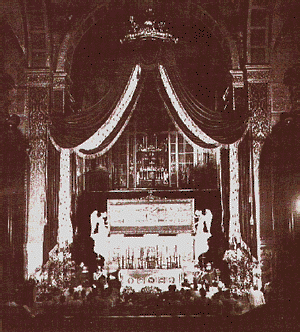 |
The Cathedral as it appeared during the 1898 Exhibition (S. Pia)
A precise reconstruction of Pia's work was realized by his son, the lawyer Giuseppe, in an accurate article in the magazine "Sindon" n. 5 (April 1961) to which we refer those people who want to have first hand information. The article quotes some documents in its appendix, among which the most important is one titled, "Memory" that Pia wrote in French (it has been translated into English and is reproduced in its entirety at the end of this article) for Arthur Loth, who published it in the volume "La Photographie du Saint Suaire de Turin", printed in Paris in 1907 (p. 17-21). The writing is dated June 29, 1907 with this short dedication: "A Monsieur Arthur Loth, pour hommage et reconnaissence", followed by the declaration: "M. Le Chevalier Secondo Pia a bien voulu rédiger son mémoire en francais; nous la donnons intégralment dans son texte". This is the only writing that Pia left about his work to offset skeptics and their criticisms that the photograph was not perfectly realized. During the polemic that arose after the photograph's release there were, besides the detractors, many people that recognized Pia's high technical qualities. Here is one such testimonial:
"Les photographies de 1898 ne sont pas d'un amateur; elles ont un valeur documentaire incontestable. Elles sont la constatation d'un fait."(1).
**********
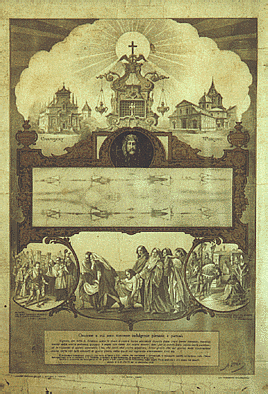 |
Poster with the prayer approved by Pope Pio IX to give plenary & partial indulgences
This large poster, reduced in size for the Internet, requires some explanation.
At the top center one sees the upper part of Bertola's altar inside the Holy Shroud Chapel. Behind the clearly visible grille is the case (not visible) that contains the reliquary with the Holy Shroud. Illustrated to the left is the Sainte Chapelle of Chambéry and to the right, the Turin Cathedral with the Holy Shroud Chapel's dome.
The center drawing below the Shroud image is a representation of the transport to the sepulchre.
As for the captions under the two outside drawings, only the left one is historically accurate: "meeting between Duke Emanuele Filiberto and St. Carlo Borromeo at the Palatina Gate". The right one is a legendary hypothesis: "Presentation of the Shroud to Goffredo di Buglione in Jerusalem".
The text at the bottom is a Prayer approved by Pius IX on September 16, 1859, that recalls in its expressions the "Oremus" of the Mass in honor of the Shroud.
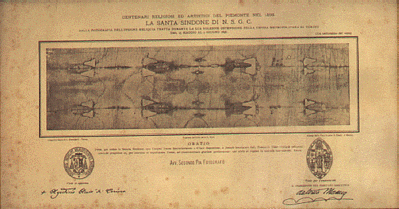 |
Picture for the "Artistic and Religious Centenaries of Piemont in 1898 -
The Holy Shroud of Our Lord Jesus Christ" (S. Pia)
The magazine of Sacred Art, published in that year (p.104), dedicated to the event the following few words mentioned by the newspaper "Italia Reale"- National Courier since June 1, 1898:
"For charge of the Committee, the only one given this authority, the Holy Shroud's photograph was taken by the lawyer Secondo Pia, a distinguished and skilled student of photographic art...
...The photograph was really a success and has an exceptional importance for religion, history and science."
The confirmation of the results did not come from official photographs like the one by lieutenant Felice Fino or the one by Jesuit Father Giammaria Sanna Solaro, who published his photograph in the work "La Santa Sindone di Torino che si venera a Torino illustrata e difesa" (Turin, 1901, p. 141-150).
The qualification of "amateur photographer" given to Pia in many following writings was a distortion of reality reestablished in its very rich objectivity through the numerous national and international recognitions rendered to him and stubbornly listed in a recent publication by Marina Miraglia in "Culture fotografiche e società a Torino 1839-1911" (p. 409-410), published by Umberto Allemandi on the initiative of "Guido and Ettore Fornaris Foundation 1990." I found two curious testimonies about this great event. Father Antonio Tonelli, in an article published in "Rivista dei giovani"(November 1929), remembering Pia's work, wrote:
"Pia told a friend of mine that once (he) placed the plate in the bath he felt the need to jump because he was so filled with emotion and happiness".
The other detail is remembered by an assistant of Pia's nephew in an article published in "Collegamento pro Sindone" (2):
"Pia was at the threshold of the dark room. In his hands he held the big plate still dripping fixative. Once close to him, my grandfather was struck by the strange expression of his face. He looked down the plate and saw...
Standing one in front of the other, the two were not able to look away from that marvellous negative image that according to their photographic experience must be in negative, instead...
It was Pia who broke first silence:
Look, Carlino, if this is not a miracle!
One cannot help but remember the interest and the work of the Salesian Father Natale Neguier de Malijay about whom I wrote in another article (3).
 |
The altar with the Holy Shroud in 1898.
Exposure proofs of Secondo Pia (S. Pia)
A very important and interesting article about Pia's various photographic sessions in 1898, with original photographic documentation, was published in "Sindon" (new series, II, n. 3, December 1991, p. 69-101), signed by Gian Maria Zaccone with the title: "La fotografia della Sindone nel 1898: recenti scoperte e conferme nell'archivio Pia", on the occasion of the donation by his son, the lawyer Giuseppe, of his father's collection regarding the Shroud: writings, documents, original photographs and plates.
I present it here in the words of the author:
"It's a fund not of great dimensions, but of notable importance. It has been munificently given by Secondo Pia's children - Giuseppe and Chiara - in successive stages, from the 60's until today. It is composed of papers, particularly correspondence, that cover a period of time from 1898 to the 1930's, and naturally, of original photographic plates, prints and reproductions of the Shroud. It also includes the large camera, whose image has become familiar to every Shroud researcher and lover, used by the photographer of Asti for the Shroud photography in 1898.
The Shroud photographic section is only a small part of Pia's marvellous photographic archives created during the many years he dedicated to this new art: 4377 plates."
**********
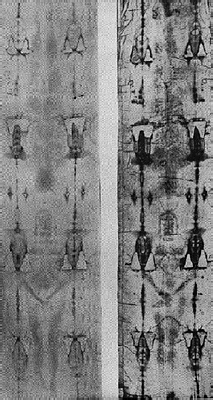 |
Cussetti's copy (left) compared with the Holy Shroud
During the Exhibition the painter Carlo Cussetti was charged with painting a life-size copy of the Shroud, according to the customs of the past.
Here is how Tonelli, who had the opportunity to talk with the artist during his work, describes the meeting:
"In 1898 Prof. Cussetti, stately painter, was charged by His Majesty (at the time the Prince of Naples Vittorio Emanuele) with creating a life-size reproduction of the Shroud. During the eight days of the relic exhibition he could copy it. He did a life-size sketch, a small "acquarello" draft and then a canvas that is exposed in the Holy Shroud Chapel sacristy. I could observe the canvas minutely at close quarters... I made the observation to Prof. Cussetti how he had drawn a very weak edging line at the sides of the face, while there is no outline on the original. And he answered me: - how could a painter draw a human body without tracing the outlines? On the contrary, first I drew with very thin strokes the whole outline, that, once I finished my work, I erased. In this place I forgot to erase it. Then he explained to me that he had to contrive a clever way to reproduce the shades gradated at the borders that one observes on the original."
This copy is now kept with an artistic frame in the Shroud Chapel sacristy.
Also the painter Enrico Reffo, in the same circumstance, depicted the Shroud from life, painting a small "acquarello" kept, according to what Tonelli writes in the quoted article, at the "Istituto degli Artigianelli" of Turin, but now no longer traceable. Although Father Tonelli doesn't mention it, it is certain, with the documentation that exists, that Reffo too depicted the Shroud in life-size. See the Table XVI in the publication "L'Ostensione della Santa Sindone", Turin, 1931 that has the following caption: "Fac-similar (that is the same as life-size) of the Holy Shroud painted by E. Reffo in 1898". And still later this was confirmed in a publication about Reffo in which one reads: "Copy of the Shroud (perhaps in the Royal Chapel closet) (sic)".
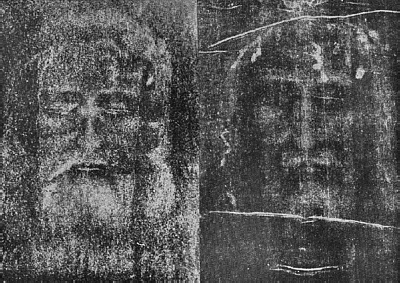 |
Face negative of Cussetti's copy (left) compared to the face on the Holy Shroud
The negatives of these two works, compared with the Shroud's negative (as one can see in the published reproduction) are the proof that, even with a sophisticated technique, it is not possible to depict accurately the reality of the somatic negative. Also that it is not possible to reproduce in positive a negative reality in all its details. With regard to life-size copies of the Shroud, other examples could be remembered, even if every one has not been found and photographed at the present:
1. - Giovanni Lanza in 1898, in a publication about which I will write later, gave this news:
"...not many years ago His Excellency monsignore Valerio Anzino, Major Chaplain of the King, prepared two copies of the Holy Turinese Cloth and presented them to Pope Leo XIII, who kept them for some days in his room, and enriched one with particular indulgences; the other one was given last year (1897) to Mons. Autin, Archbishop of Chambéry."
2. - A copy of the Holy Shroud is kept with particular care in an artistic wooden case in the great church of the Divine Providence's Small House (Cottolengo) in Turin. This copy, on May 26, 1898, was placed in contact with the Original while a crystal was applied to the big frame to protect the Shroud from dust. The fact is documented by the Minutes that are enclosed with the copy.
3. - A life-size example, dated back to 1650 with the writing: AB ORIGINALI NVPER ABSTRACTVM TAVRINI ANNO DOMINI 1650, was displayed at the Show of Sacred Art in K Room, Section 1, Showcase 29 with the following writing:
"Holy Shroud fac-similar drawn from the original in 1659. It belongs to Countess De Ponverre de Ternier born in Gay di Montariolo, Turin." At present the copy is kept in Turin by the noble family heirs. The copy, during the exposition, was photographed by Pia for Paul Vignon.
"M. Le chevalier Pia a eu l'obligeance de photographier ce document à mon intention. Je suis heureux de remercier M. Le comte de Montariolo d'avoir bien voulu autoriser cette reproduction." (4).
4. - Another life-size copy of the Shroud, not well specified nor identified, was exposed in the Holy Shroud church during the triduum of preparation for the event. Such was the news that one read in "Italia Reale" May 9-10, 1898 on the first page, bottom, on the left:
"The solemn preparation triduum to the Holy Shroud Exhibition.
The announced triduum began yesterday in the Holy Shroud church (Deposito street). For the occasion, a life-size image of the Holy Shroud was placed at the high altar under a magnificent crimson velvet mantle with golden fringes. The flow of the devotees was great and the Canon Reyna, with that particular eloquence of heart of his own, told what the lessons of the Holy Shroud are."
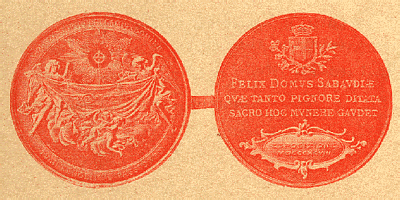 |
Memorial medal coined for the 1898 Exhibition
**********
To complete the foregoing information, I will list some publications of the end of the century and, particularly, of 1898, published on the occasion of the Exhibition, announced by various articles in the newspapers and, as for the religious field, by the pastoral letters of the Bishop of Pinerolo, Giovanni Battista Rossi, and the Bishop of Novara, Edoardo Pulciano.
Mons. Rossi's pastoral is a quite ample treatment of 34 pages.
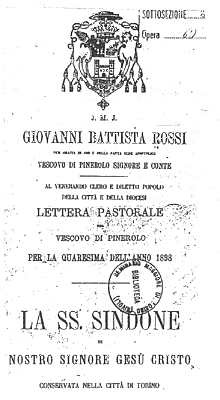 |
Pastoral letter of the Bishop Giovanni Battista Rossi
The first part is dedicated to justify the veneration of the relics against the Waldenses and the Protestants, fairly numerous in the diocese. In the second part he traces an historical excursus about the Shroud's vicissitudes, and in the third part he goes back to the veneration of the relic and admonishes the believers to cultivate a reasonable and right veneration for the Shroud. Mons. Pulciano's writing is much shorter, and consists of only eleven pages, rich with moral and pastoral reflections. It starts from the consideration that sin has been and still is the cause of Christ's passion and death. Then he recalls the affirmation that only Christ's blood delivers us free from sin, blood shed on the cross and visible on the Shroud, salutary cleansing occurs in true receiving of the sacraments. The exhortation concludes with a call to the sad conditions of the Church of those times in Italy and with the invitation to pray "for the Holy Church, our Mother... for the Vicar of Jesus Christ, our Holy Father Leo XIII and for all of us with the purpose to prepare ourselves to celebrate the Easter mysteries with death to sin and the resurrection to the Christian life.
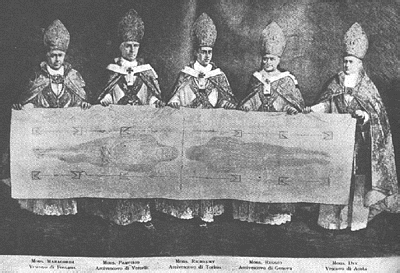 |
1898 Exhibition. From left to right: Mons. Manacorda, Bishop of Fossano;
Mons. Pampirio, Archbishop of Vercelli; Mons. Richelmy, Archbishop of Turin;
Mons. Reggio, Archbishop of Genoa; Mons. Duc, Bishop of Aosta.
**********
Here is a list of some other early publications about the Shroud.
CHIUSO TOMASO, "La S.S. Sindone di N.S. Gesù Cristo venerata nella Reale Cappella in Torino", Turin. 1885, p. 144.
The author of the book, "warmly commented" by Cardinal Gaetano Alimonda, Archbishop of Turin, to promote the veneration for the Holy Shroud, in the dedication to the reader expounds the purpose of his work and lists the treated themes:
"The purpose I have intended writing these short accounts about the Shroud is to keep in the Turineses the veneration for the Holy Relic alive... I tell what is written in the Gospel about the Shroud; what the Fathers, the writers of the Church and History, the ecclesiastical dispositions tell about it; the potentates operated for it, and the praises addressed to the Shroud... I conclude with some formulas of prayer to Our Lord's Passion with reference to the Shroud (p. 5-6)."
BOUCHAGE LEON, "Le Saint Suaire de Chambéry à Sainte-Claire-en-ville", (Avril- May 1534), Chambéry, MDCCCXCI, p.37.
The brochure about which I wrote in previous articles (5) is the text of the communication presented at a congress of savoyard scholars in 1890. It's precious because it quotes the report of the Clarisse Nuns of Chambéry that mended the Shroud after the fire in 1532. In addition to this report some events that preceded it are recalled and news about the 1868 Exhibition are reported.
LANZA GIOVANNI, "La Santissima Sindone del Signore che si venera nella R. Cappella di Torino", Turin 1898, p. 166 with illustrations.
However with a small size (cm 19 x cm 12) the volume contains much precious information and is richly documented with news quoted from archives and libraries of the city. The edition is well edited, also from a typographic point of view, with very good illustrations for that time. The publishers were the well known Roux Frassati and Partners.
It's still always of useful consultation. Very interesting is the reproduction (one could think of a photocopy) of aVittorio Amedeo II's autograph letter to the blessed Sebastiano Valfrè; it carries the date October 8, 1706, a month after the liberation from the siege of the French and it is transcribed at pages 124-125.
ARTUFFO GIO.BATTA, "La Regia Confraternita del SS. Sudario e B.V: delle Grazie", Turin, 1898, p. 164.
The author, Rector of the Brotherhood and of the homonymous church built by itself, expounds in various chapters the history of the Brotherhood from its constitution (1598) until 1898. The most interesting chapters, to which one hopes to come back more broadly, are those that describe the Pazzarelli Hospital's foundation, the construction of the Holy Shroud church, the construction of an ampler Hospital, the foundation of the Retreat-Boarding school for the Soldiers' daughters, the suppression of the Brotherhood, the renewal of activities after the Napoleonic storm, and finally, the reform of the new mental hospital's administration transferred to the civic authority.
In the work "Universe Catholicae Doctrinae Explicatio atque Defensio", the author GUGLIELMO RAMELLO gives a "Dissertatio historica et critica", about the Holy Shroud: "De Sancta Sindone evangelica quae in regio sacrario apud Ecclesiam Metropolitam Taurinensem servatur et colitur". The dissertation was also translated and published apart with the title: "L'omaggio dei secoli alla Sacra Sindone evangelica venerata nella chiesa metropolitana di Torino".
VIGO GIOVANNI BERNARDO, "De Sindone evangelica", Turin, 1898.
Latin poem in two books and an Appendix published in 1768 and newly edited in that year in an edition edited by Vincenzo Lanfranco dedicated to Baron Antonio Manno, President of the exposition of Sacred Art.
Among the many brochures of divulgation and piety I recommend:
BARBERIS GIULIO, "Descrizione e storia della Santissima Sindone con alcune divote preghiere in Suo onore", Turin 1898, p. 31. The titles of other publications could be found in the bibliographical list of Dervieux, n. 64-79 bis; 352-353; 394-399; 434-436.
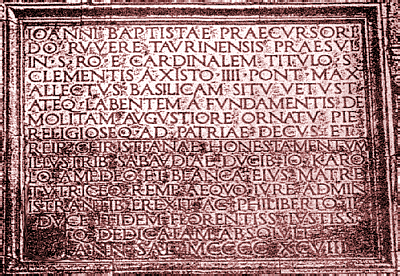 |
Inscription engraved on the Cathedral face
upon the main portal between the two windows
**********
I conclude with two news items from the life of two worthy shepherds, Mons. Rosaz, Bishop of Susa and Father Marchisio, parish priest of Rivalba Turinese, both elevated to the glory of the altars. In Mons. Rosaz's life one reads that in its circular letter n. 71 to the clergy and the believers of the diocese he warmly invited to participate to the diocesan pilgrimage with the constitution of a Commitee that could organize its carrying out. The participation was really substantial considering the number of the participants, 2945, as it is remembered in the life with another detail:
"In that occasion the valley-dwellers of Susa took to Turin their varied and cheerful note, since the women from the different towns went on pilgrimage with the costumes of their respective town, this made the procession very picturesque." (6).
In parish priest Father Marchisio's life one reads:
"On the occasion of the Holy Shroud Exhibition in 1898, the holy parish priest wanted to take to Turin an imposing pilgrimage of Rivalba citizens, and he himself went from door to door to stimulate his numerous parishioners to take part in it." (7).
It could be almost impossible to retrieve newspapers of that period to read the news of those days. I refer those of you who want news on this matter to the chapters XXV-XXVI (p. 135-150) of the work already quoted by the Jesuit Father Giammaria Sanna Solaro. "La Santa Sindone di Torino...", Turin 1901.
**********
MEMORY
about the photographic reproduction of the Holy Shroud of Turin realized on the night of May 28, 1898.
To Prof. Arthur Loth
On May 1898, approaching the date of the solemn Exhibition of the Holy Shroud, it was thought to photograph the Relic.
I offered myself to do that work, at my whole expense and with the renunciation of any copyright.
This proposal, through the authoritative support of Baron Antonio Manno that honors me with his friendship, was warmly accepted by our Sovereign, His Majesty Umberto, who was kind enough to grant only me the special authorization.
My worry was great and deep, especially because I had to photograph a subject that I have never been able to see. According to those people who contemplated it during the previous Exhibitions, the Holy Shroud presented only very weak imprints. Moreover there were the uncertainties represented by the illumination and the conditions in which I would have been able to operate. Indeed the difficulties that arose were considerable.
First of all I asked the realization of a special stage in front of the altar on which the Holy Relic was exposed and I placed there a camera with a size of cm 50 x 60. I tried a first attempt on May 25 night, first day of the Exhibition, but a very serious obstacle arose for my work because of the illumination. This was constituted by two electric lights placed in front of the altar and at the stage's sides, that concentrated their rays in such a way as to make unequal the illumination on the Relic's surface. Then I tried to remedy this drawback placing two frosted glasses in front of the flood-lights, to get a more diffused and uniform lighting, but the heat caused by the sources of light (one with a power of 1000 candela and the other of 950) after only five minutes from the first exposure caused the breaking of the glass.
Since the Cathedral should have been opened to the rightly impatient crowd, I had to put off my work to another day.
In the meantime I applied to the two flood-lights another frosted glass, at a distance of m 1.50 to prevent the breakup and I resumed my work at 21.30 on May 28.
But this time too there were new problems.
During those three days a crystal has been placed in front of the Holy Shroud to protect it from dust and that made my work more difficult . Moreover I had to set up the stage and the camera at a larger distance, eight meters from the altar, because the lights and the decorations of the church reflected on the crystal.
Another obstacle was represented by the instability of the electric current, because the plate's exposure was a necessarily long one and I needed a constant light without interruptions. I have found however, a polite and effective helper in the person assigned that service and it was possible to get what I needed.
However, the two lights, supplied of currents produced by two different power stations, didn't have an equal light intensity and that is - as I have already told - one was at 1000 candela and the other at 950, as could be evidenced from the photograph's examination.
All these details are confirmed in a deed drawn up by the Notary Cav. Giuseppe Cantù of Turin, undersigned by witnesses and about which some publications have already spoken.
I have exposed two plates cm 50 x 60, one with an exposure of 14 minutes and the other with an exposure of 20 minutes, using a Voigtlander lens with a diaphragm of two millimeters. I have placed before the lens a very faint yellow filter using orthochromatic plates of the "Edward" firm, developed in a normal solution of ferrous oxalate, without any special chemical preparation that could somehow alter the development's usual result.
Closed in the dark room, all intent upon my work, I felt a strong emotion when, during the development, I first saw appearing the Holy Face on the plate, with so much emphasis that I was surprised and together cheerful since I could from that moment be sure about the good result of my enterprise.
Afterwards I fixed the plate in a sodium hyposulphite solution.
It is evident that I have never had the pretension of "inventing" any special method nor used any tricks, like some people wish to believe. Of very great use to me indeed was my long experience - even if that of an amateur - in reproducing paintings and colored objects, very often in bad conditions of illumination, that made possible a notable exposure.
I can also give my word of honor that neither the negatives nor original plates nor the following reproductions intended for the printing were in any way retouched. In support of such a categorical declaration I could present the evidence of various people that, kindly interested in my work, had the opportunity to observe the original negatives the day after their impression.
It has also been said that the photograph was taken "through transparency" but this remark hasn't any foundation because everybody knows that the Holy Shroud, owing to its bad conditions of preservation, due to the work of the time and to the various accidents, is lined with a cloth of red silk that doesn't allow any transparency.
To provide an explanation to all the critics, one claimed the "positive" result of the plates was caused by an "overexposure" caused by an unexpected chemical phenomenon or some special procedure during the development.
Apart from what I declared about the normal development procedure I followed, the observation of the "overexposure" is very clearly belied by the first original photograph realized for trial and of which I send a copy to your Lordship. In this photograph, besides the Holy Shroud, is also reproduced the frame and a part of the altar on which the Relic was exposed. Now it is evident that if an "overexposure" of the plate occurred, then the two angels set at its sides would have appeared in "positive" like the Holy Shroud, that is white and therefore appearing black after the printing. It is not possible to conclude that the "overexposure" occurred only in a part of the photographic plate.
Some well known studies of photographic chemistry were done and conclusions arrived at about the duration of the exposure that should have been used, without knowing, before giving their opinion, what kind of illumination I had, which kind of lens and its opening I used, if I used the yellow filter, what were the quality and the sensibility of the plates and above all which special difficulties presented the photographic reproduction of the Holy Shroud.
Here is therefore, eminent Sir, my report, in brief, simple and sincere words, about the way I carried out such an important work.
I hope that my loyal declarations have destroyed all these hypotheses that I am believed to have done and that you and other experts have been able to fight eminently, showing their groundlessness and defending together the honesty that has inspired my work, honesty doubted with so much thoughtlessness by people that, for their indisputable value, should have shown greater caution in their judgments.
The best recompense for my work is the success obtained and, still more, to have provoked such important discussions about our Holy Relic.
Turin, June 29, 1907
signed Lawyer Secondo Pia
**********
References
(1) Thomas M. Pregues, in Revue Thomiste, June 1902, pag. 349-350.
(2) C. Capriata, Miracolo, March/April 1991, pag. 38-47.
(3) L. Fossati, Un oscuro promotore della ripresa fotografica della Sacra Sindone nel 1898: il salesiano Don Natale Noguier de Malijay, Collegamento pro Sindone, July/August, 1988, pag. 8-42.
(4) P. Vignon, Le Linceul du Christ, Paris, 1902, pag. 159.
(5) A che cosa può servire la tela d'Olanda, Collegamento pro Sindone, September/October 1992, pag. 3-12 - Relazione delle Suore Clarisse di Chambéry che nel 1534 rammendarono la Sacra Sindone, Collegamento pro Sindone, May/June 1993, pag. 3-11.
(6) G. Calabrese, Monsignor E. G. Rosaz, Susa 1914, pag. 433.
(7) D. Franchetti, Il Santo Prevosto di Rivalba Torinese Don Clemente Marchisio, Turin 1933, pag. 319.